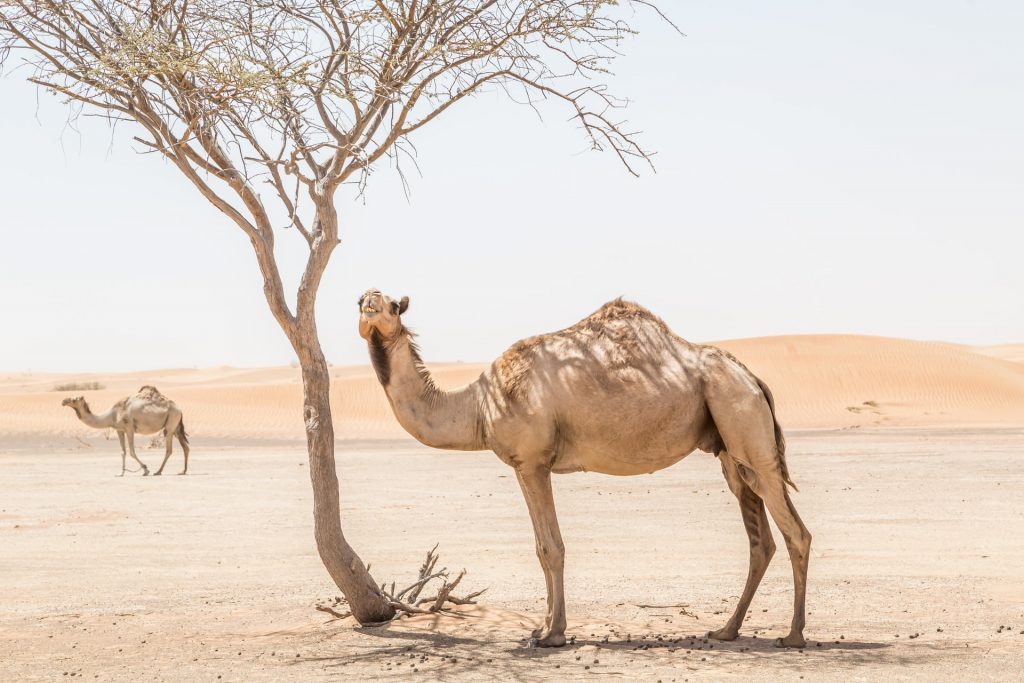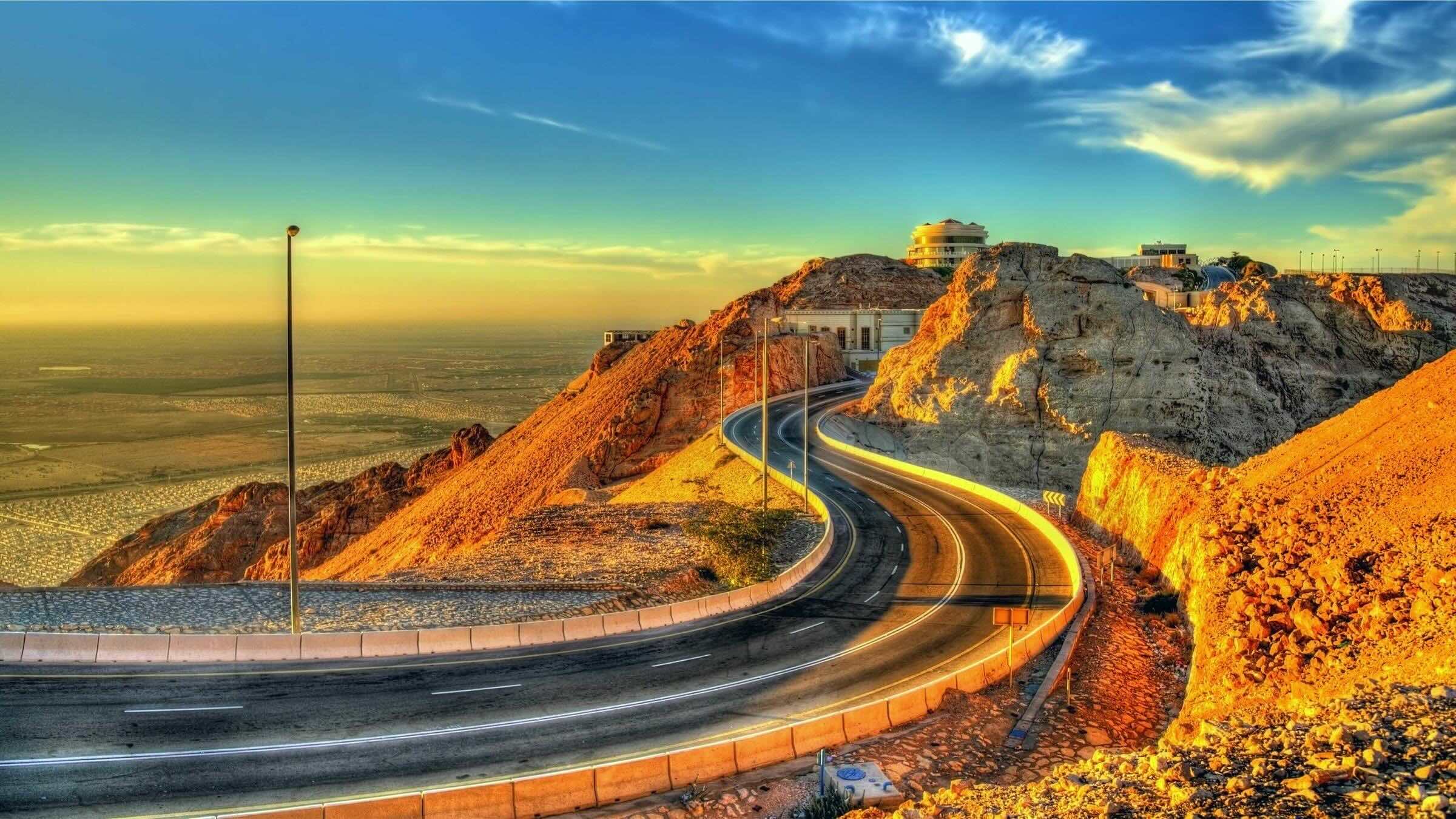It’s not just palm trees in Abu Dhabi’s garden city.
Between its natural springs and palm groves, Al Ain offers endless appeal to those deprived of nature and desperate to escape city life for a few hours – especially with the return of cooler temperatures. But a closer look reveals that the capital’s garden city also boasts historical forts, hidden gems, striking vantage points, a UNESCO World Heritage Site, an impressive showcase of wildlife, and plenty more. Here, we delve into seven attractions worth visiting and who they’re best suited to.
Al Ain Camel Market
for the UAE newbie
We recently paid tribute to the beloved camel by revealing nine camel-centric experiences that await across the UAE and, naturally, Al Ain Camel Market made the cut. Sensory overload aside, it’s the perfect way for new expats to immerse in the country’s true culture – camels have always been at the centre of life in the GCC, after all. The sheer spectacle of haggling and trading (these hoofed mammals are either suited to racing or purchased for breeding purposes) takes place early in the morning and is a sight worth catching, especially if a complete departure from life in Dubai is what you’re after.

Al Ain Oasis
for the nature enthusiast
We’d be remiss not to include Al Ain Oasis, arguably known as garden city’s ultimate attraction owing to its tranquillity. Spread across 1,200 hectares and the first UNESCO World Heritage Site certified in the UAE, this oasis is famed for offering insights into the ancient ‘falaj’ irrigation system that brings water from the mountains via a complex system of underground and surface channels, and continues to nourish it today. It’s also our favourite place to immerse in nature; the many pathways within Al Ain Oasis are shaded by towering fruit trees (mango, orange, and fig among others) and more than 147,000 date palms. Bonus: you can explore the premises on foot, on horseback, or by bicycle. Elsewhere, a miniature oasis, interactive displays, and presentations on date harvesting add an educational aspect.

Al Ain Safari
for the animal lover
While Al Ain Zoo needs no introduction (the beloved attraction has been operating since 1968), this 217-hectare park is yet to be discovered by many. Home to one of the world’s largest man-made safaris, it houses a range of African animals and close to 2,500 plants. Adding a sense of place to the overall safari experience, meanwhile, are the Emirati guides who steer the SUVs – they have extensive knowledge of the vicinity’s flora and fauna, white rhinos and African lions included. And while activities like feeding the giraffes and dining at the edge of the park’s lion territory make for a memorable outing, it’s the conservation efforts that animal lovers will value most; critically endangered or locally extinct species such as the addax and scimitar oryx roam free in the wild here.

Al Qattara Arts Centre
for the artsy type
Housed within a traditional mudbrick residence and home to permanent exhibitions, archaeological findings, and classes (everything from painting and drawing to handicrafts and music sessions are on offer), Al Qattara Arts Centre has single-handedly elevated the arts scene of Al Ain. It’s also one of Al Ain’s leading events venues – this cultural landmark often marks milestones by showcasing the works of local artists or screening films by Emirati talent. The programming changes according to season, but regardless of what’s on the agenda, there’s plenty to while away a couple of hours.

Hili Archaeological Park
for the history buff
For a slice of history that’s more easily accessible – and recognised by UNESCO – Hili Archaeological Park is both family-friendly and furnished with extras like go-karts and tennis courts that accent the earliest known evidence of an agricultural village dating back to 3000 BCE. Elsewhere, the likes of tombs, strongholds, old dwellings, and irrigation systems also offer a glimpse into Al Ain’s Bronze Age and Iron Age past. Incidentally, the circular Hili Grand Tomb is considered the crown jewel of this sprawling park as it’s over 4,000 years old and the largest monument of its kind in terms of the size of stones used. While you’re here, take a moment to linger by the two entrances until you spot the engravings.

Jebel Hafeet
for the petrolhead
Few roads manage to garner fame like the one that ascends Jebel Hafeet, and for good reason. Not only was it ranked third among the world’s most beautiful road trip routes (according to Instagram data released by Pentagon Motor Group), but also dubbed the “greatest driving road in the world” by American motoring company Edmunds. At 1,249 metres, Jebel Hafeet is the second-highest mountain in the country and is located close to the border with Oman. Petrolheads in particular will appreciate the smooth drive up to its summit and the desert views that come with it – two wide lanes that boast 60 corners and snake up the limestone mountain, topping out at an elevation of 1,219 metres above sea level.

Jebel Hafeet Beehive Tombs
for the adventurer
Own a four-wheel drive and up for a little off-roading? The tombs at the base of Jebel Hafeet beckon. Believed to be 5,000 years old, these remnants of an ancient cemetery still contain the skeletal remains of Al Ain’s earliest inhabitants. Hundreds of dome-shaped tombs have been found in this area, with artefacts suggesting trade links with Iran, the Indus Valley (modern-day Pakistan and India), and ancient Mesopotamia (modern-day Iraq). Getting here is half the adventure – a bumpy ride and a complete absence of facilities follows soon after you exit the roundabout when following Google Maps towards Jabal Hafeet National Park near the Mezyad Border Post.



